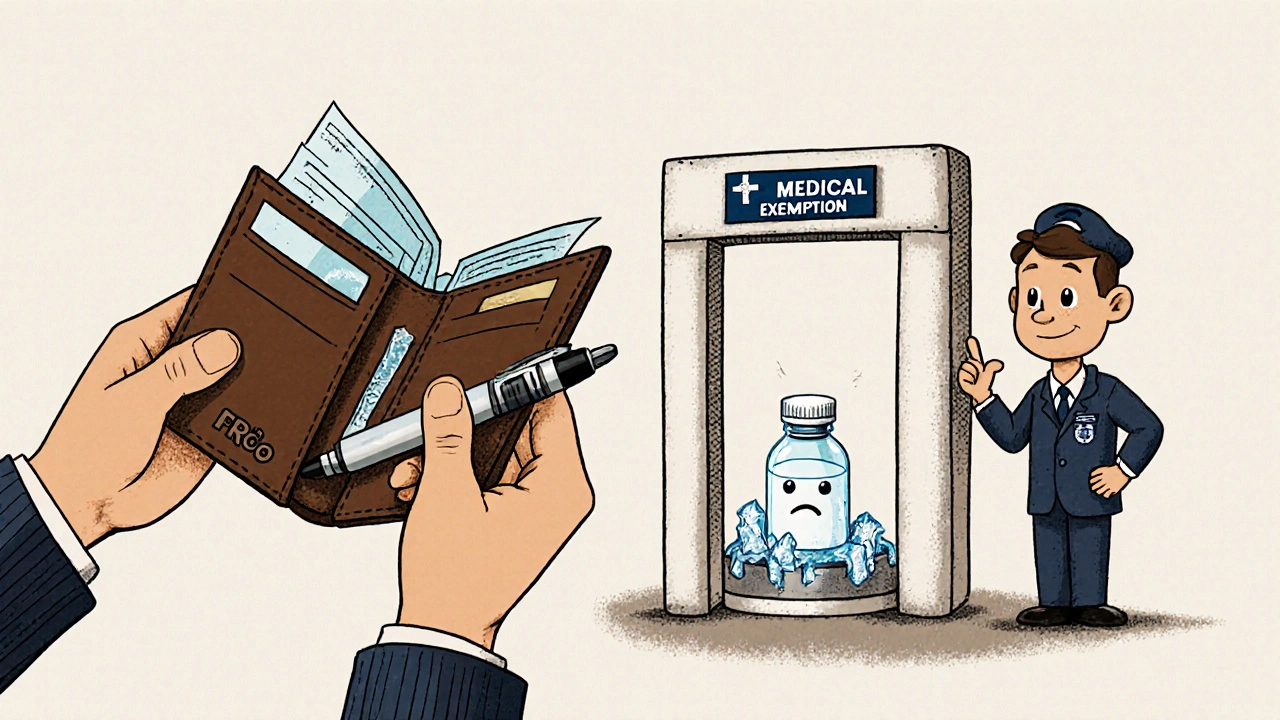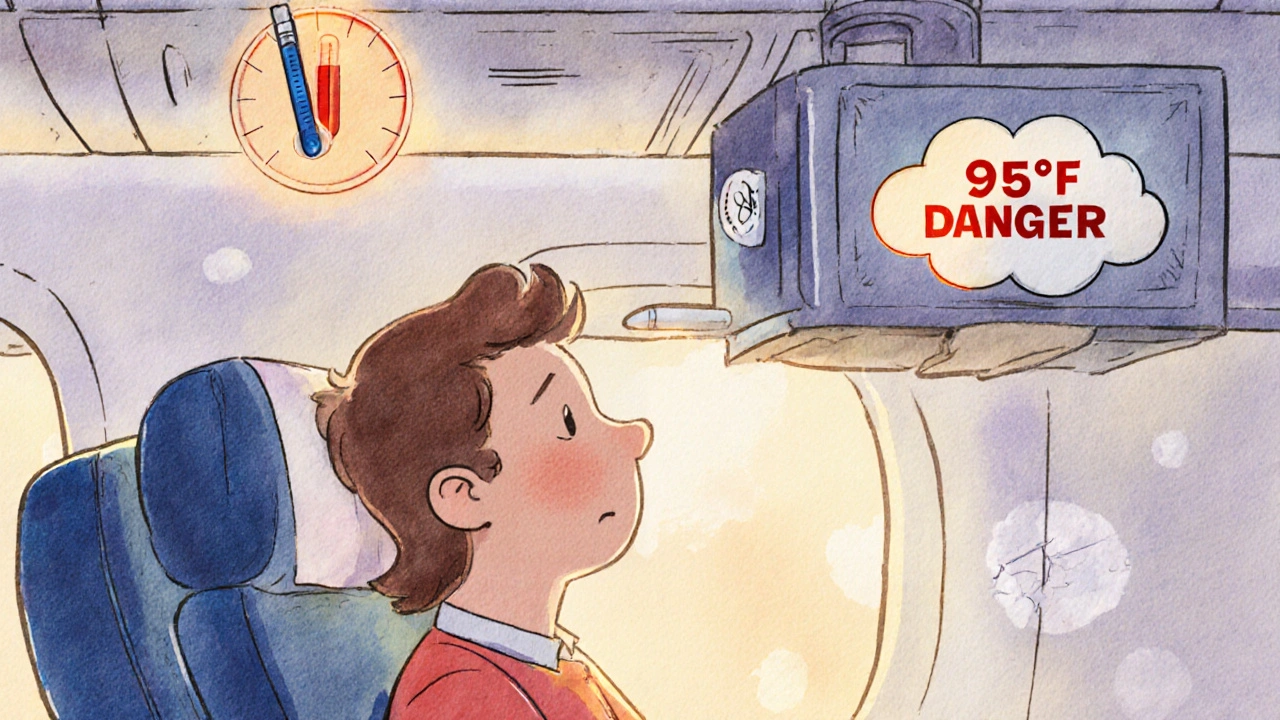When you're flying across time zones with insulin or biologics like Ozempic, your medication isn't just a pill in your bag-it's life support. A single 14-hour flight can turn your carefully managed diabetes into a medical emergency if your insulin gets too hot, too cold, or sits in an overhead bin where temperatures hit 95°F. This isn't theoretical. Real people have ended up in emergency rooms because their insulin degraded mid-flight. You don't need to panic, but you do need to know exactly how to protect your medication.
Why Temperature Matters More Than You Think
Insulin isn't like coffee or medicine you can leave on the counter. It's a protein. Too much heat-above 86°F (30°C)-starts breaking it down. Too much cold, especially freezing, destroys its structure completely. Once damaged, insulin won't lower your blood sugar. You won't feel sick right away. But over hours or days, your levels creep up. That's when ketoacidosis, confusion, or even coma can happen. The FDA says unopened insulin must stay between 36°F and 46°F (2°C-8°C). Once you start using it, it's fine at room temperature (59°F-86°F or 15°C-30°C) for up to 28 days. But here's the catch: most planes aren't designed for medical storage. Cabin air is kept at 65°F-75°F, which sounds safe. But near windows? That can hit 90°F. In the cargo hold? It can drop to -40°F. That's why where you store your insulin matters more than what you store it in.What Happens If You Put Insulin in the Overhead Bin
It's tempting. You're trying to save space. You think, "It's just a pen, it'll be fine." But according to data from the American Association of Clinical Endocrinologists (AACE), 41% of travelers who stored insulin in overhead bins experienced dangerous temperature spikes. One study tracked insulin in a carry-on bag placed in the overhead compartment on a 12-hour flight. By the end, the insulin reached 95°F. The insulin looked cloudy. The person had to use a backup pen-and still ended up with blood sugar over 400 mg/dL. The problem isn't just the sun. Aircraft skin heats up during flight. Even if the cabin feels cool, the walls and ceiling can be 20°F hotter. That's why experts like Dr. Anne Peters say the worst place to store insulin is the outer pocket of your carry-on, right next to the window. It's a death trap.Where to Keep Insulin During the Flight
The safest spot? Your seat-back pocket. Yes, the one behind the seat in front of you. Boeing's own environmental data shows that area stays between 68°F and 75°F (20°C-24°C) during flight. That's within the safe range. You can reach it easily. You can check it every few hours. And it's not near any heat or cold source. If you're using an insulin pump, keep it on your body under your clothing. Don't remove it unless you're changing the site. CGMs (continuous glucose monitors) can stay on too. They're designed to work at altitude. Never put insulin in checked luggage. The cargo hold isn't just cold-it's freezing. One traveler lost a vial of insulin after it froze solid during a 10-hour flight. The insulin turned into a chunky sludge. It was useless.Best Cooling Solutions for Long Flights
You need something that keeps insulin cool without freezing it. Ice packs? Risky. A 2022 University of Colorado study found that 23% of insulin vials froze when placed directly next to standard ice packs. That's because ice is 32°F. Insulin can't touch it. Here are the proven options:- FRÍO Wallet: This is the most popular choice. It uses water-activated crystals. You soak it in water for 15 minutes, then slip your insulin inside. It keeps insulin between 59°F and 72°F for up to 45 hours-even in 104°F heat. It's lightweight, fits in a purse, and costs about $35. Diabetes UK and NHS England both recommend it.
- BreezyPack Pro: Uses phase-change material. Keeps insulin stable between 50°F and 72°F for 72 hours. More expensive ($50), but lasts longer. Good for multi-day trips.
- TempMed Smart Case: Launched in November 2023, this is the first Bluetooth-enabled case. It connects to your phone and alerts you if temperatures go above 82°F. Clinical trials showed 99.2% efficacy preservation over 16-hour flights.
- Evakool Thermostatic Case: Maintains 39°F-46°F for up to 120 hours. Great for long trips, but heavy (2.2 lbs) and needs pre-cooling. Overkill for most travelers.
A 2023 Diabetes Online Community survey found that 78% of travelers now use water-activated wallets like FRÍO instead of ice packs. Why? Fewer freezing incidents, less mess, and no TSA issues.

What TSA Allows (And What They Don't)
You have the right to bring insulin and cooling devices on board. TSA regulation 1544.219 says medical cooling containers are permitted in carry-on bags. But that doesn't mean every agent knows it. Here's how to avoid delays:- Carry a doctor's letter dated within the last 6 months. It should say you have diabetes and need insulin. 92% of travelers with this letter avoided security delays, according to TSA data.
- Keep insulin in its original pharmacy packaging. Labels with your name and prescription info are gold.
- Don't pack ice packs larger than 3.4 ounces (100ml). That's the liquid limit. If you need more cooling, use a FRÍO wallet-it's not considered a liquid.
- Have a digital copy of your prescription on your phone. If your physical copy gets lost, you're covered.
- Never try to hide insulin. Declare it. Say, "I have diabetes and need to keep my insulin cool." Most agents will nod and move on.
In 2022, TSA handled over 12,000 insulin-related incidents. About 23% involved ice packs being confiscated. That's avoidable.
Biologics Like Ozempic: Different Rules
If you're using a GLP-1 agonist like Ozempic, Wegovy, or Mounjaro, the rules are stricter. These drugs are more sensitive than insulin.- Unopened: Must stay between 36°F and 46°F (2°C-8°C).
- Opened: Can stay at room temperature (59°F-86°F) for only 56 days (per Novo Nordisk's 2023 data). After that, potency drops.
- Never freeze. It's irreversible.
- Use the same cooling methods as insulin. FRÍO and BreezyPack work fine.
One traveler on Reddit reported her Ozempic pen turned cloudy after a 16-hour flight. She thought it was just air bubbles. It wasn't. She had to replace it mid-trip and ended up with nausea and vomiting from uncontrolled blood sugar. Don't assume it's the same as insulin.
What to Do Before, During, and After the Flight
Before you fly:- Pre-cool your insulin in the fridge for 2 hours before packing. Don't freeze it.
- Place it in your cooling wallet with at least 0.8 inches (2 cm) of space between the insulin and the cooling material.
- Bring at least 200% of your expected dose. Delays happen. Time zones mess with your schedule.
- Label your insulin clearly. Write your name and dose on the case.
- Keep your insulin in your seat-back pocket or on your body.
- Check it every 4 hours. Look for cloudiness, clumping, or discoloration. If you see it, discard it and use your backup.
- Don't let it sit in the sun during layovers. If you're in a hot airport, keep it in your bag under your seat.
- Test your blood sugar more often for the first 24 hours. Your body might react differently to degraded insulin.
- If you suspect your insulin was compromised, switch to your backup immediately.
- Keep your used vials or pens. If you need to file a claim with the airline or manufacturer, you'll need proof.

Time Zones and Dose Adjustments
Changing time zones affects your insulin timing. This isn't optional-it's medical.- Eastward travel (losing time): If you're flying across 6+ hours, reduce your long-acting insulin dose by 20% for the first day. Your body's insulin needs drop when you sleep less.
- Westward travel (gaining time): Increase your long-acting insulin by 15% for the first day. You're stretching out your day, so your body needs more coverage.
- For short-acting insulin, stick to your meal schedule based on your destination time, not your home time.
These adjustments come from the American Association of Clinical Endocrinologists' 2022 guidelines. Don't guess. Do the math.
What to Do If Your Insulin Gets Damaged
If you see clumps, cloudiness, or crystals in your insulin-throw it out. No exceptions. Here's your emergency plan:- Use your backup insulin immediately.
- Call your doctor. They can fax a new prescription to a local pharmacy.
- Use your phone to find the nearest pharmacy. Apps like GoodRx or Walgreens can locate one in minutes.
- If you're overseas, contact your embassy. They often have lists of local medical suppliers.
One traveler in Germany lost her insulin on a 14-hour flight. She called her endocrinologist, who emailed a prescription to a local pharmacy. She got a new supply within 90 minutes. She had a backup plan. That's why she stayed safe.
Future of Traveling with Insulin
The good news? Things are getting better. The International Civil Aviation Organization (ICAO) is requiring all major airlines to offer temperature-controlled storage compartments on request by late 2024. New insulin formulations are in development-targeting 45 days of room-temperature stability by 2026. But until then, your responsibility is clear. You're not just carrying medication. You're carrying your health. Don't leave it to chance.Can I bring insulin on a plane in my carry-on?
Yes. The TSA allows insulin, syringes, pens, and cooling devices in carry-on luggage. You must declare them at security. Keep them in original packaging and carry a doctor's letter dated within the last 6 months to avoid delays.
Can I put insulin in checked baggage?
Never. Checked baggage can reach -40°F in the cargo hold, which will freeze and destroy insulin. It can also get extremely hot during ground delays. Always keep insulin with you in your carry-on.
How long can insulin last without refrigeration during travel?
Most insulins are stable for up to 28 days at room temperature (59°F-86°F). Insulin Degludec can last up to 56 days. But if temperatures exceed 86°F for more than 4 hours, it should be discarded. Always check for cloudiness or clumping.
Do I need a doctor's note to fly with insulin?
It's not required by law, but a doctor's letter dated within the last 6 months reduces security delays by 92%, according to TSA data. It should state you have diabetes and need insulin for medical reasons.
Is it safe to use ice packs with insulin on a plane?
Only if the insulin doesn't touch the ice. Direct contact can freeze it. Use a cooling wallet like FRÍO instead. It's safer, TSA-friendly, and keeps insulin at a stable 59°F-72°F without risk of freezing.
What should I do if my insulin looks cloudy after a flight?
Discard it immediately. Cloudiness means the insulin has degraded and won't work. Use your backup pen or vial. Test your blood sugar more often for the next 24 hours. Contact your doctor if you need a replacement.
Can I bring my insulin pump on a plane?
Yes. Keep it on your body. Do not remove it unless changing the site. CGMs can stay on too. Inform security you're wearing a medical device. They may do a pat-down instead of a scanner.
How do I adjust insulin for time zone changes?
For eastward travel (losing time), reduce your long-acting insulin dose by 20% for the first day. For westward travel (gaining time), increase it by 15%. Always adjust based on your new meal schedule, not your home time zone.
